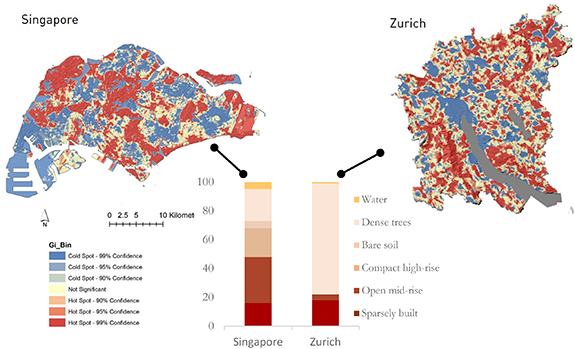Impact of urban densification on ecosystem services
Researchers from the Future Cities Laboratory investigate the relationships between urban forms and ecosystem services in the tropical city of Singapore and temperate city of Zurich.

In efforts to develop liveable cities, built up areas are further densified, thus reducing urban sprawl, protecting agricultural and amenity land, and helping reduce energy consumption. However, densifying urban areas also puts high pressure on urban green spaces and the provision of ecosystem services, directly affecting people's quality of life. The supply of and demand for urban ecosystem services differ greatly across the globe.
In this paper, Prof. Adrienne Grêt-Regamey, principal investigator of the Ecosystem Services in Urban Landscapes project team at the Future Cities Laboratory (FCL) programme and Natural Capital Singapore as well as Maria Angela Dissegna, researcher of the Ecosystem Services in Urban Landscapes project team at FCL, and their co-authors, derive a set of urban forms and their related ecosystem services in both a temperate and a tropical city.
The results of the study showed that the supply of urban ecosystem services does not increase linearly with green area coverage, but is highly dependent on the urban form. To support the regulation and provision of ecosystem services in built up areas, the proportion of trees are particularly important while the surfaces covered by infrastructure and the buildings also play a key role.
Open midrise neighbourhoods in Singapore and Zurich have a similar average surface-to-volume ratio but neighbourhoods in Singapore provide more water flow regulation and air pollution control services. In contrast, microclimate regulation, seems to be independent of the location but depends more on the amount of built up surface.
The researchers also observed that open midrise neighborhoods synergistically support the supply of many regulating services in both cities, including microclimate regulation, water flow regulation and air pollution control. Large water and forest patches are unquestionably essential in both Singapore and Zurich to support bundles of ecosystem services, particularly also for recreational activities.
Comparing both cities showed that decreasing the amount of built up area is essential for the provision of ecosystem services, and that the supply of ecosystem services is not only linked to the surface-to-volume ratio of the buildings but particularly to the amount of infrastructure around the buildings. Therefore, the management of the areas around the buildings is important. Trees are especially important for air pollution control and water flow regulation. Finally, large patches of green and blue areas are essential for supporting a high quality of life in both cities, especially if they are accessible.
The urban typologies and their related ecosystem services bundles derived from this study can provide applicable practical knowledge that can help decision-makers to better evaluate the advantages and disadvantages of densification options.
The paper external page "How urban densification influences ecosystem services — a comparison between a temperate and a tropical city" is published in Environmental Research Letters.